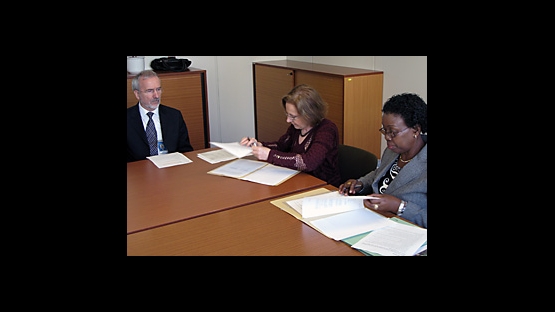African countries joined forces with the IAEA to take a decisive step in the fight against the tsetse fly, the main carrier of parasites that cause sleeping sickness in humans and trypanosomosis in animals. The pest has long been a serious health hazard, significantly hindering development across much of the African continent.
Thanks to the increased use of Sterile Insect Technique (SIT), a nuclear-based pest control technology that is often described as "biological birth control for insects", African countries are expected in future to clear more of their territories of this deadly insect.
In SIT-supported pest suppression and prevention campaigns, millions of sterilized male insects are released into targeted areas. They mate with wild females in the field, but no offspring are produced. Eventually, the pest population is suppressed and steadily reduced over time.
A Memorandum of Understanding (MoU) in support of the African Union´s initiative on the Pan African Tsetse and Trypanosomosis Eradication Campaign (AU-PATTEC) was signed on 25 November 2009 by the IAEA and the African Union Commission (AUC). The agreement reinforces the SIT component of the tsetse fly eradication efforts throughout the African continent.
The MoU was signed by Ana María Cetto, IAEA Deputy Director General and Head of the Department of Technical Cooperation, and Rhoda Peace Tumusiime, AUC Commissioner for Rural Economy and Agriculture.
"I am happy and proud to be signing this memorandum today," said Ms. Cetto.
"We hope that this cooperation framework will increase the chances of success in the fight against this pest, and that results are seen in a not too distant future."
Ms. Tumusiime expressed strong appreciation for the IAEA´s support to African countries in their effort to rid the continent of the tsetse fly. She also asked for cooperation between the IAEA and African countries in areas such as water management, animal health and food security to be reinforced.
"We hope this memorandum will provide a springboard for our various undertakings together," she commented.
In his remarks expressed during the signing ceremony, Werner Burkart, IAEA Deputy Director General and Head of the Department of Nuclear Applications, stressed the fact that the IAEA is strongly committed to African development.
"This memorandum is proof of the fact that we share a vision of how to tackle development issues in Africa. We have always taken African development and well-being very seriously," he said.
"In SIT in Africa we are not yet where we would like to be, but we can build on our enthusiasm. Hopefully, this memorandum will help us overcome problems," he concluded.
In signing the MoU, the IAEA agreed to enhance its collaboration with AUC in areas including exchange of data and information; training and national and regional capacity-building; research; and development of national legislation and regulatory measures.
Background
For more than 30 years, the IAEA has been an active partner of African Member States and provided substantial support in the fight against tsetse fly.
From 1992 to 2008, over $25 million were disbursed to tsetse-related projects, including capacity building, research and technical assistance to Member States. The successful eradication of the tsetse fly Glossina Austeni from Zanzibar in the period from 1995 to 1997 integrating SIT with insecticide-based suppression techniques has re-enforced the concept of creating tsetse-free zones and clarified the role of the SIT.
The AU-PATTEC was launched 2001 by the African Heads of State and Government to lead and coordinate the continental effort to achieve the long-term goal of eliminating the problem of the tsetse fly and trypanosomosis from Africa.
Over the past years, the IAEA General Conference adopted several resolutions in support of AU-PATTEC.


